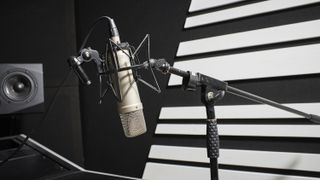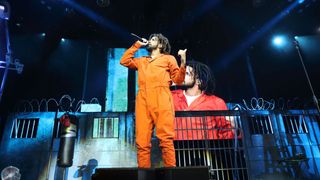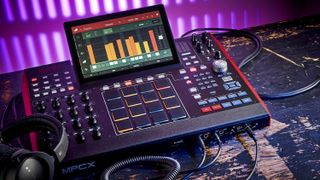Born Sinner, the sophomore full-length by Fayetteville, N.C.-bred MC/producer J. Cole, debuted on June 18, 2013, a bump up from its original release schedule. Unlike many albums rushed to streaming services and pressing plants to counter an early leak, Cole’s move was a ballsy decision to go head-to-head with another release that day: Kanye West’s Yeezus. It was a statement of confidence by Cole, who wasn’t content to be a follower behind his Roc Nation labelmate.
That conviction was rewarded. Opening at Number Two behind Yeezus, Born Sinner sold nearly 300,000 its first week, moved to Number One within two weeks, and as of late fall 2013 had moved more than 600,000 units. Multiple singles from the album topped Billboard’s Mainstream RnB/hip-hop radio airplay chart, each one fueled by Cole’s personal production.
Cole’s production style is equally informed by childhood violin lessons and youth orchestra as it is by sample chopping and pad banks. He has been spitting rhymes and arranging beats since receiving his first sequencer at age 15. Self-taught on keyboard, Cole transitioned over the years from programming unrelenting bangers to playing breathing melodies, always trying to master more engineering techniques to compensate for strings and choirs.
For Born Sinner, Cole started work on most tracks while on tour in 2011; he worked on his MacBook Pro, then finished most sessions at Premier Studios (New York City), employing the facility’s SSL J 9000 console, a wealth of outboard processing, and Augspurger, JBL, Yamaha, and Mackie monitoring systems to showcase the crisp instrumentation and potent low-end reinforcement of the album. Though Cole collaborated with a few producers to polish samples and sessions, and a half-dozen tracks feature guest appearances from singers and MCs, the core of Born Sinner is 16 tracks of clarity, soul, and power largely realized by Cole himself.
Speaking from a car while rushing between appointments on his What Dreams May Come tour, Cole discusses how he’s found a balance and future direction for his production, with additional insight, contributed by mix engineer Juro “Mez” Davis.
Walk us through the first time you heard a song and started to think about how it was produced.
Cole: "I think the first time I started paying attention to production was around 1997: the year Biggie’s second album [Life After Death] and Puff Daddy & the Family’s album No Way Out came out. Puff’s crew [The Hitmen] was sampling all these older songs that my mom would recognize, or my stepfather would call out, so I got into the credits to find out who produced the songs.
"But the first time I got interested in how to make something was listening to Timbaland productions, trying to figure out how he did those things. I couldn’t even fathom it, where you would get started, but I was interested. On Aaliyah’s third album [Aaliyah, 2001], the song More Than a Woman was so next-level to me. I just sat there trying to imagine how he made it. After that, I started trying things on the [Ensoniq] ASR-X Pro [Resampling Production Studio]... the red machine with just the drum pads."
When you first started on the ASR-X Pro, did you approach beats by establishing a tone or pattern first?
Cole: "At first I would only make a beat when I found a sample I got excited about, so I was going through my mom’s CD piles, from Dire Straits and Steely Dan to Bob Marley and Marvin Gaye. And when I finally found something that excited me, I’d sample it and then put drums around it. It was always music first, and I got better and better at putting drums to samples I chopped or looped. But then I watched a Pete Rock interview and he was like, 'I always start with drums first.' At first, I couldn’t imagine it, but it stuck with me, so one day I did start drums first and it changed the whole trajectory of me as a producer.
"I was only 15 but I had mentors that were in their early 20s, and one of them made all his beats on an MPC and he burned me a copy of his drum CDs. The first ones were from this company EastWest, and suddenly I had all these one-off hits I could go through till I found the sounds I liked. It was way more fun; I didn’t need a sample loop or something from someone else for inspiration now. Now in 25 seconds I can scroll through my folders and cook up a drum pattern, some rhythms that inspire me, and then I can add a sample or play something on top or get someone to play on top."
Working with those first tools, what was a trick you found to thicken things up to make those drum hits stand out in a way that was yours?
Cole: "You had to adjust the input level of the ASR. It’s analogue, so you could play around to get it close to peaking, but you had to get it just right to not distort while still high on that meter. I’m sure there were other tricks, but I’m not the type to read the manual. I only wanted the beats to rap on, so I didn’t learn the ASR inside out."
Did your style of battle rap at the time influence the way you made beats?
Cole: "Not in terms of levels, but in terms of the dirtiness... When I was doing battle stuff, I wanted the drums disgusting sounding. I’d loop these super old breakbeats that were as dirty as I could find and then I’d put hard drums on top. Even now, to this day, if I’m doing a beat with a dirty drum loop, it will have a really hard, loud kick on top that really snaps."
When do you think you started to establish enough confidence to flip your initial style?
Cole: "I would always have both aggressive and mellow, deep stuff. I liked the emotional and moody beats, too. But when I really found a groove as a producer was around the time I did “Lights Please” [on Cole World: The Sideline Story, 2011]. I didn’t have to try as hard; I trusted my instincts, and I didn’t have to add 100 drum sounds or samples on top of each other. I had a drum loop, a kick drum, a melody, a sample, and a snare.
If you listen to Lights Please, you can hear this vocal sample that’s on every snare with just keys on top; there’s really four or five elements to that beat and that’s when I hit that level of confidence to not overdo things. That’s when I started to hit that comfort level."
By that point, what was your core gear?
Cole: I had switched to [Propellerhead Software] Reason because the thing that always bugged me with the ASR was I couldn’t play anything. I was limited to samples and drums. So when I got introduced to Reason, I fell in love with all these instruments. I could make a beat the same way, but then I could pull up a piano on top and play some keys, then go through all these bass lines to choose the one I want. Getting to touch the keys and play changed the whole thing. I could now see how Timbaland made that More than a Woman beat–with a guitar, live bass, synths, etc.–so it opened my mind to what you could do with more layers."
How did you position your new layers and play with the listening experience?
Cole: "Honestly, I use tools like panning to clear up space, especially now that I’ve grown as a producer, but in my early stages there was no such thing–just sounds piled on top of each other. Only now am I starting to take control of things that used to be done in the mix. Now I’m doing EQs, reverbs, delays, panning, etc. while making the beat. I didn’t have the mixing ear at first, just an ear for melody and drums and adjusting the volume of the sounds. This album [Born Sinner] was the beginning of my putting more motion in the sound design, and it’s only scratching the surface."
What’s your current platform?
Cole: "I still use [Propellerhead Software] ReCycle to chop samples, but I’m in [Apple] Logic now. I kind of want to make the switch to Ableton [Live] because I’ve seen what it can do, but right now I’m married to Logic and a USB keyboard; it’s usually the M-Audio 49 or 69, but it doesn’t even matter what kind as long as it plugs in and I can touch the keys. Whatever else is around–live bass, live guitar, a Moog Voyager–I use an Apogee Duet to record it directly into Logic. I also pack Beats by Dre headphones, and I’ve used Yamaha NS10, Mackie HR824, and M-Audio BX8 monitors outside of the commercial studios."
Given a choice between the analogue and virtual gear, what’s your preference?
Cole: "My next album I want to make everything analogue. In terms of mixing, I can hear the difference when we put things through that SSL board [in Premier Studios]. In terms of instrumentation, I’d also like to use analogue, but I can’t deny that the quality of these synth plug-ins is pretty amazing. In terms of drums, it’s very important that people understand that digital drums, putting up a WAV kick and putting it into your session, is not good enough. That kick needs some sort of analogue boost or some plug-in that can mimic that analogue boost, add some width. Just sampling a kick into that ASR would give it a different sound than loading it in Logic."
Walk us through a song, explaining how you stacked the beat.
Cole: "The song Power Trip [featuring Miguel], I started that beat real simply. That 808 you hear, it’s coming out of Logic with filters and into distortion, I added to destroy the sound a little, because that’s what those analogue samplers were doing. That’s the vibe I try to mimic, adding distortion or compression to an 808 or kick to give it some body and presence. A lot of it was on the digital side, but then me and my engineer Mez ran that sound through the SSL board and tweaked it because of how you can push the low-end extension on that board without peaking."
Mez: "For most of the reverbs and delays we keep it in the box, using stuff like the Lexicon plug-ins and maybe [Audio Ease] Altiverb. Then we’d go out to the board where I’d make a lot of tweaks with the [Empirical Labs] Distressors and [Teletronix] LA-2A. Sometimes I’ll over-compress stuff, or a lot of times I’ll take a dry sound and a distorted sound, compress the shit out of the one, and blend the two together. Then we printed it all back in through the SSL board to get a real analogue sound, that drive that goes far without sounding cut off–one where we’re still able to do even more tweaks."
Cole: "Then on the hook, we wanted to make it sound like I was literally listening to a love song on the radio, so we threw effects on there."
Mez: "On Miguel’s vocals we used a Distressor, a Pultec EQH-2 and a Neve 1073, crunching them pretty hard to make it sound a little more tube, a little older than it was. We went extreme with it at first, but then it seemed too much, so there ended up just being a slight frequency cut at the top and bottom to get that FM squash. We distorted things a bit, and then added a reverb that’s also on the drums; that was actually done in L.A. at Record Plant and was a vintage EMT 140 plate."
Cole: "Kick, snare, hi-hat, 808, bassline, sample, keys, strings, etc.–I dug deeper into Logic for getting the levels of effects on the parts right, then I bounced it all out and sent it to Pro Tools for Mez to mix.
"All the drums were right, balances were already good, so it was a little EQ, automation, and reverb at first, not so much a worry about levels or underprocessing and overprocessing. I did most of the heavy shifting left and right, working on making the album real wide."
Once you’ve established the beat and effects and it’s time to add vocals, do you look for a mic that’s neutral so you can work with it in the box or do you pick one that will add colour to the track upfront?
Cole: "I prefer for the mic, or at least the compressor, to give me more presence. It didn’t use to be that way–it was more under the beat, but now I need more width. I don’t need to dominate the beat, but I need a healthy presence over it."

The best studio microphones for instruments, vocals and podcasts
Have you found a preferred signal chain?
Cole: "I kind of freestyle every time. The Avalon [VT-737sp] is great, but sometimes I don’t have that and just have the Duet so that will do. And for the mic, the [Neumann] U87 is usually what we use. There’s also a Sony mic, the C800G, that’s great."
Mez: "An Avalon and U87 is a classic combination. It’s hard to mess up. But we also used the Sony C800G through the Neve 1073 and Tube-Tech CL1B, and sometimes the Avalon or the [Universal Audio] 1176LN to stop his voice from sitting under the beat. I think the C800G is a little more present because it has a great top end, which makes you stick out more. And something like the Avalon is more midrange, so it’s giving depth, girth. The Avalon I usually set at attack fast release, and then I’ll ease off the attack till no matter how he’s rapping, a little bit of the initial transient is coming through. Then from there, I’ll set the release depending on what the style of vocal is, making it slower or faster till it sits well with the track."
So once you have all the parts together, where do you have to work the hardest to make it all sit comfortably?
Cole: "It’s definitely the balance between the low end. Power Trip is a perfect example again. There’s an 808 there that needs to live, needs to be heard. But there’s a bass line going at the same time that’s just as important. They’re in each other’s way but both need to be there, so it’s about carving the space, finding the right ratio of taking from the 808 without taking too much of its life, and the same with the bass line. That’s where we had to spend the most time. And also the vocal mix is something I’m trying to master."
Have you found any personal tricks that allow you to tweak the parts without compromising the idea?
Cole: "When we’re mixing, Mez would split one sound into two or three set parts. A perfect example is that percussion part in Power Trip, where there’s a channel with only the high end, a channel with mids and one that’s only the sub, and we adjust from there."
Mez: "On that track, there’s a kick, an 808, and a bass line, which is really hard to put together. The kick is mostly punch, the 808 is mostly sub, and the bass is everywhere, upfront, with a lot of low-mids and high-mids. I’d split it up in the box with filters, and then from there put it on the board. On the high-mids or the very highs, I used an actual [Roland] Dimension D to make it wider, then it was just about making sure the sub and the 808 didn’t kill each other. In my mind, a lot of what makes it work is left and right panning and the perception of things being in different places.
"I experimented awhile to find how to deal with the percussion taking up so much space. Everything was supposed to be loud at once, so I split the percussion, used two EQs, and panned it differently; the drums are more to the left and the hat more to the right. There’s a drum filter going through all of it that’s heavy affected. There’s a Mellotron, and I flipped phase on each side so they have opposite polarities and it’s really wide-sounding. I use SoundToys PanMan and Waves MondoMod, which is a little more flange-y, to do a lot of automation unless I want something super-specific and then I’ll draw it in the box. For example, I automated the Waves Kramer Master Tape emulator and a Waves Doubler on intro and outro vocals on Power Trip. There’s one vocal track in the love songs part that gets wider every other line and one with more extreme tape distortion that comes up every time it reaches the 'all night' part, making those phrases really pop."
Cole: "It took a lot of going back and forth, tweaking little parts in Mez’s initial mix, but we got it just right. Having the option to balance things because you split them up and pan them out like that gives you another weapon in your arsenal, another tool to fix problems. For me, it’s all about learning new tricks, because I want to do more sound design and engineer more action in my beats in the future."



